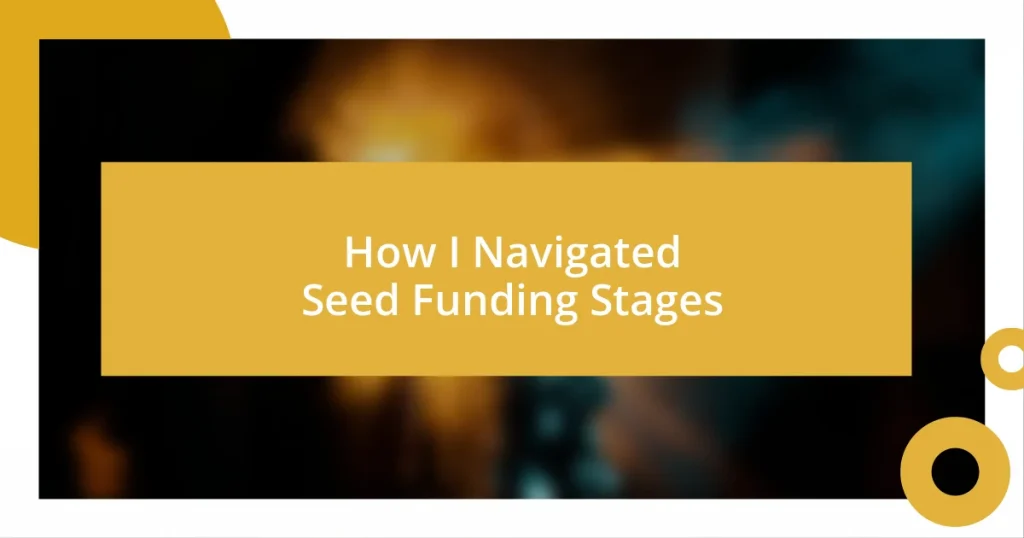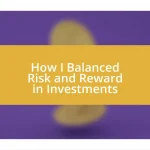Key takeaways:
- Seed funding is not just about financial support; it involves finding partners who believe in your vision and can provide valuable feedback to refine your approach.
- Craft a compelling pitch by weaving personal stories, clear problem statements, and strong market opportunities together to create an emotional connection with investors.
- Post-funding strategies should focus on establishing measurable KPIs and maintaining strong investor relationships through regular updates and open dialogue to foster collaboration and innovative solutions.

Understanding Seed Funding Basics
Seed funding is often the first step for startups seeking to transform their ideas into reality. I vividly remember the rush of excitement—and anxiety—when I pitched my first idea to potential investors. It’s a crucial time where you’re not just searching for money, but for partners who believe in your vision.
At its core, seed funding is about gathering the resources to develop your product and validate your market. I learned firsthand that this stage isn’t just financial support; it’s an opportunity to gather invaluable feedback. Did you ever wonder how the right investors can challenge your assumptions? I had my fair share of pivotal discussions that shaped my approach, revealing insights I had overlooked.
Understanding the landscape of seed funding is essential for laying your foundations. I often think back to the diverse array of opportunities—angel investors, crowdfunding, and even incubator programs. Which one is the best fit for your startup? I found that asking myself this question helped narrow down my options and focus my efforts.

Identifying Your Funding Needs
Identifying your funding needs requires a clear understanding of what your startup must achieve at each stage of development. I remember sitting down with a whiteboard and mapping out my goals and the resources I would need—what a chaotic yet enlightening experience that was! It’s essential to differentiate between immediate funding needs, like product development and marketing, and longer-term objectives, such as expanding your team or entering new markets.
Here are some specific areas to consider when identifying your funding needs:
– Product Development: What resources do you need to create and refine your product?
– Market Research: How much will you invest in understanding your target audience and competitors?
– Operational Costs: Consider expenses like salaries, rent, and tools essential for day-to-day operations.
– Marketing Strategy: How much do you need to effectively reach your audience and get traction?
– Future Growth: What kind of funding will ensure you can scale and innovate over time?
Taking inventory of these needs was a game-changer for me. It was almost like clearing the fog that clouded my vision. When I focused on each area, it became easier to pinpoint how much funding I’d realistically require and where to seek it. This clarity ultimately led to more effective conversations with potential investors.

Crafting a Compelling Pitch
Crafting an engaging pitch is truly an art form. I recall my first pitch meeting vividly. My heart raced as I stood in front of investors, showing off not just numbers but the passion behind my startup. It’s important to convey your story authentically; people invest in ideas that resonate with them on a human level. I found that when I infused my personal journey and the challenges overcame, it helped create a connection with my audience. Have you ever felt that spark when sharing your vision? That’s the magic you want to capture in your pitch.
An effective pitch goes beyond just presenting facts and figures; it’s about creating a compelling narrative. I realized my pitch became most powerful when I told the story of how my idea originated. Drawing from my experiences, I shared the inspiration that drove me to start this journey—how a personal moment led to the creation of something meaningful. This blend of emotional appeal and solid data can entice investors far more than a barrage of statistics. Investors are not just looking for a great product; they want to believe in the person behind it. Can you share the inspiration behind your vision? Connecting personal experiences can be your key differentiator.
To illustrate how different components of your pitch can work harmoniously, here’s a comparison that highlights essential elements:
| Pitch Component | Description |
|---|---|
| Introduction | Grab attention; share your personal story. |
| Problem Statement | Define the issue your product addresses clearly. |
| Solution | Demonstrate how your startup provides a unique solution. |
| Market Opportunity | Showcase the potential size and growth of your market. |
| Call to Action | End with a clear ask; explain what you want from investors. |
Each element plays a crucial role in forming a convincing pitch. By weaving them together with sincerity and clarity, you’re not just presenting information; you’re inviting investors to join you on a shared journey.

Building Relationships with Investors
Building relationships with investors is one of those aspects that can transform your funding journey. I remember when I first started approaching investors; it felt daunting, like stepping into a world where I didn’t quite belong. But what I quickly learned is that cultivating genuine relationships is more important than presenting numbers. I made it a point to engage with potential investors beyond just funding opportunities, sharing insights about my industry and listening to their experiences as well. Have you ever found that a friendly chat can lay the groundwork for a more fruitful partnership?
Networking plays a crucial role in building these relationships. I found immense value in attending industry events and conferences where I could connect with investors in a more relaxed environment. It was during one of these gatherings that I struck up a conversation with an investor who, after a short chat about market trends, expressed interest in my work. This personal touch often leads to more meaningful discussions about your startup later on. It really reinforces the idea that behind every investor, there’s a person who appreciates connection just as much as you do. How do you approach networking opportunities in your journey?
Consistency is what ultimately solidified my relationships with investors. Regular updates about my progress, even if they weren’t asking for it, went a long way in building trust. I initiated monthly email updates, sharing milestones and challenges I faced. This transparency demonstrated that I valued their input and expertise. Plus, they felt more like partners in the journey, not just financial backers. Have you considered how maintaining an ongoing dialogue could impact your relationships? In my experience, I genuinely believe it sets the foundation for success in securing the support you need.

Navigating Term Sheets Effectively
Navigating term sheets can feel like deciphering a complex code, especially if you’re new to seed funding. I vividly remember the moment I first received a term sheet. My initial reaction was a mix of excitement and confusion. Understanding the terms—like equity stakes and valuation—was crucial because these details would shape the future of my startup. Have you ever stared at a document, wondering what all those legal terms really mean? I certainly have, and it’s a moment that demands both attention and clarity.
One of the best pieces of advice I received was to focus on the key terms that significantly impact my equity and control—the valuation cap and the dilution provisions, for instance. The valuation cap sets the maximum valuation at which my investment would convert to equity. I made the mistake of overlooking this, leading to a more significant dilution than I anticipated. This experience taught me the value of scrutinizing every detail. Have you considered how each term could affect your ownership stake in the long run?
Additionally, establishing a strong line of communication with potential investors was invaluable during this process. When I had questions about specific terms, rather than hesitating, I reached out for clarification. One investor took the time to explain the rationale behind certain clauses, which not only alleviated my concerns but also helped me appreciate their perspective. Trust me, those conversations were a game changer. So, how do you navigate these discussions? I found that being proactive in seeking clarity not only demystified the term sheet but also fostered a stronger relationship with my investors.

Leveraging Feedback for Improvement
Feedback is a powerful tool that can catalyze improvement in your startup journey. I remember distinctly when I sought feedback after my initial pitch to a group of investors. They provided insights not just about what I presented but also about how I communicated my vision. Hearing their perspectives was eye-opening; it made me realize that sometimes, it’s not just about the numbers, but how you convey the passion behind your project. Have you ever received feedback that fundamentally shifted your approach? I certainly have, and it was a game-changer.
Incorporating feedback isn’t just about making surface-level changes—it’s about fundamentally evolving your business. After those initial meetings, I took the time to genuinely reflect on the feedback I received. One core suggestion was to clarify my value proposition. I went back to the drawing board, distilled my message, and shaped it into a more compelling narrative. The next time I presented, I could see the difference in the investors’ engagement. They weren’t just listening; they were genuinely interested. This approach made me realize that valuing others’ opinions can unlock doors I hadn’t even considered before. How do you see feedback shaping your business strategies?
Creating a feedback loop with mentors and investors solidifies a culture of continuous improvement. After my first successful round of funding, I made it a point to follow up with the investors who had offered constructive criticism. I asked them specific questions about what they thought I’d implemented well and what could be further refined. Their responses not only provided valuable direction but also deepened our relationship, as it demonstrated my commitment to learning and growth. It was an affirmation that I was not just seeking their money but their guidance. Have you thought about how creating channels for feedback can elevate your startup? I genuinely believe that nurturing these dialogues is key to long-term success.

Successful Post-Funding Strategies
Once the funding is secured, implementing a robust post-funding strategy is crucial for ensuring growth. I recall the thrill of closing my round and the pressure that came with meeting investor expectations. During those early days, I was hyper-focused on managing the funds effectively while still staying true to my vision. Have you ever felt torn between multiple priorities? I certainly did, and it led me to develop a clear roadmap that prioritized both financial management and strategic growth initiatives.
One particular strategy that significantly paid off for me was establishing measurable KPIs (Key Performance Indicators). Defining these metrics early created a sense of accountability within my team. I remember sitting down to brainstorm which KPIs were most aligned with our business goals. It was a process that unveiled valuable insights into our operations. For instance, tracking customer acquisition costs not only helped optimize our marketing spend but also allowed us to pivot quickly based on performance trends. What key metrics resonate with you and your business objectives?
Additionally, nurturing investor relationships post-funding proved to be a game changer. I made it a point to schedule regular updates, transforming what could have been a one-sided reporting process into a collaborative exchange. I vividly remember one quarterly check-in where I shared both our wins and the challenges we faced. To my surprise, instead of just offering sympathy, my investors provided innovative solutions that I hadn’t considered. Have you tapped into the wealth of knowledge your investors offer? I found that these candid conversations not only strengthened their trust in me but also sparked fresh ideas that propelled my startup forward.















